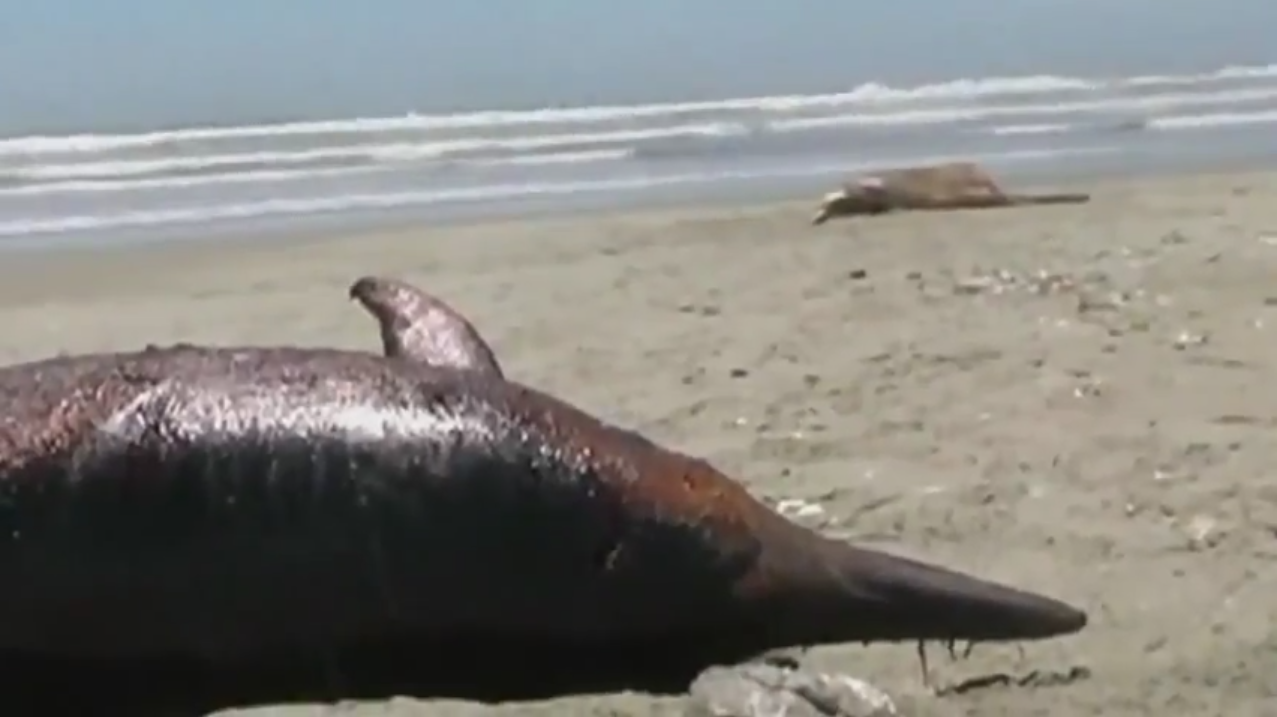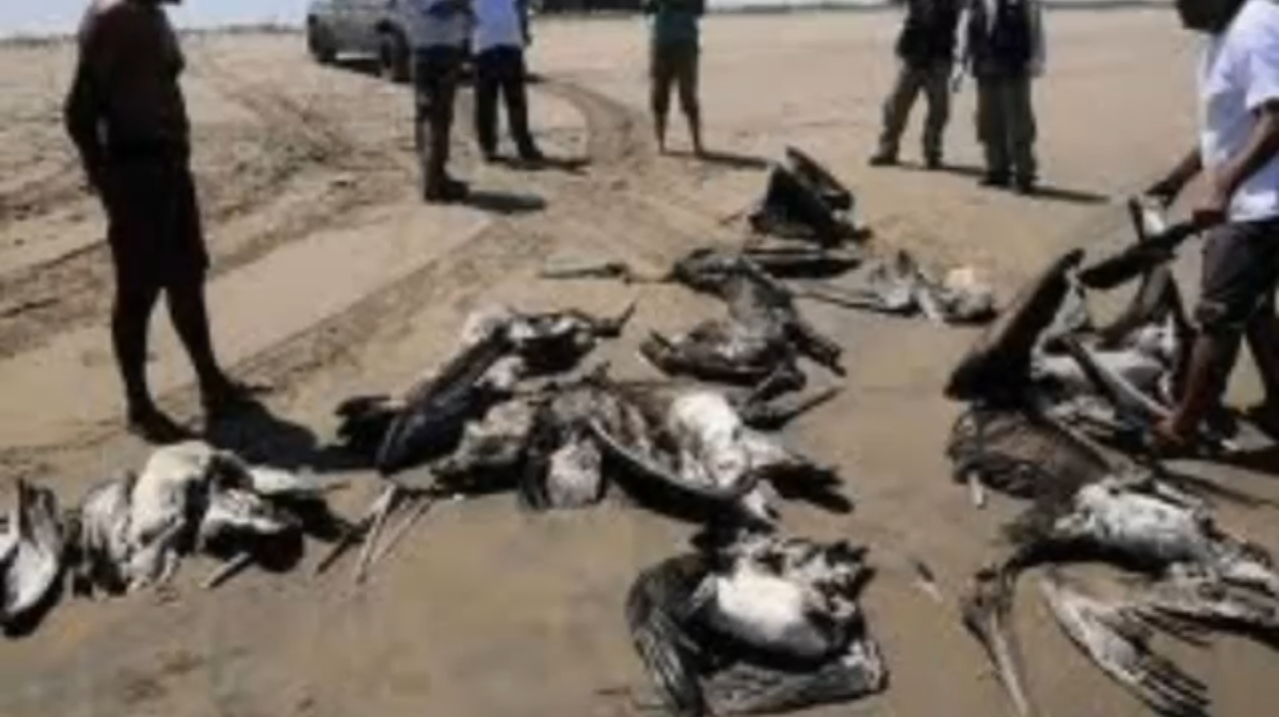Mysterious Mass Deaths Claim Dolphins & Pelicans

Nearly 900 dead dolphins have washed up on the beaches of northern Peru since February. Autopsies have revealed air bubbles and blood in their sinuses, indicating they suffered from "the bends," or decompression sickness, after a panicked, rapid ascent to the ocean's surface. If this is the case, what is spooking so many dolphins, and is that why they died?
Marine biologists initially suspected that a form of underwater sonar used by oil and gas prospectors might have frightened the mammals, which use acoustic signals to communicate and find prey; what the dolphins would have perceived as loud booms may have caused them to try and escape to the surface, only to meet painful deaths. Acoustic trauma has caused mass whale and dolphin deaths in the past, and oil companies are currently prospecting off the coast of Peru.
However, this week, another clue has complicated the picture: The carcasses of some 1,200 pelicans and other seabirds washed ashore. Sonar wouldn't have killed them.
"It's not out of the realm of possibility that the dolphins had a run-in with seismic testing or sonar, and the birds had a run-in with something else," Sue Rocca, a marine biologist at the Whale and Dolphin Conservation Society, told Life's Little Mysteries. "But it's more likely that the two events are connected."
The dolphins and birds may both have eaten the same poisoned fish, for example. According to Rocca, toxicology studies on fish in the area could reveal if they were poisoned by domoic acid from an algal bloom. Algal blooms can be worsened by warming sea surface temperatures — which have recently been recorded in the eastern Pacific — and by pesticides dumped into the oceans.
Alternatively, some experts suspect the marine animals may have died of a viral infection. Paul Nachtigall, director of the Marine Mammal Research Program at the University of Hawaii, said the case appears similar to a mass dolphin stranding along the East Coast of the U.S. some 30 years ago, when the dolphins were found to be infected with morbillivirus, a killer related to measles. Birds can be infected with a version of this virus also. According to Rocca, the key question is: "Can the same strain infect both?"

However, neither the poisoning nor a viral disease theory accounts for the autopsy evidence that at least some of the dead dolphins suffered from the bends. Only 12 autopsies were performed out of 877 dolphin carcasses, so it is possible that the sample wasn't representative, Rocca said. Judith Denkinger, a marine biologist at the Universidad San Francisco de Quito in Ecuador, said the acoustic impacts resulting from seismic surveys might have harmed the pelicans indirectly by killing the fish — which can also suffer from acoustic trauma — that serve as the bird's primary food source. However, if starvation killed the pelicans, their cadavers would probably have been noticeably more emaciated than they were, the scientists pointed out.
Sign up for the Live Science daily newsletter now
Get the world’s most fascinating discoveries delivered straight to your inbox.
No single hypothesis accounts for the mass deaths of both species, and the scientists said the Peruvian government must continue its investigation. Whatever the answer, the bottom line is that there are many ways in which human activities harm the marine ecosystem, Rocca said. "It's not just one thing that these animals have to deal with. Noise pollution, chemical pollution, plastic pollution — these have cumulative impacts."
Dolphin deaths in the Gulf of Mexico last year have been traced to the 2008 BP oil spill, as oil exposure can gradually destroy dolphin's immune systems, leaving them susceptible to epidemics. Biologists at the International Fund for Animal Welfare (IFAW) are still investigating the cause of mass dolphin strandings on beaches in Cape Cod, Mass., in January and February and again in April. In total, 214 common dolphins became trapped by low tides in the area and died this year, compared with 10 or 12 stranded dolphins found in the area in a typically year, said Brian Sharp of the IFAW.
"We're trying to figure out why this larger group of animals came in so close to shore and spent so much time in this area. There are so many different factors. Was the water temperature warmer? Were their prey shifted to a different area? The oceans are so dynamic that trying to narrow it down to one cause, we just don't know what all the other pieces are doing," Sharp said.
As Rocca put it, "This is just a crap year for dolphins."
This story was provided by Life's Little Mysteries, a sister site to LiveScience. Follow Natalie Wolchover on Twitter @nattyover. Follow Life's Little Mysteries on Twitter @llmysteries, then join us on Facebook.
Natalie Wolchover was a staff writer for Live Science from 2010 to 2012 and is currently a senior physics writer and editor for Quanta Magazine. She holds a bachelor's degree in physics from Tufts University and has studied physics at the University of California, Berkeley. Along with the staff of Quanta, Wolchover won the 2022 Pulitzer Prize for explanatory writing for her work on the building of the James Webb Space Telescope. Her work has also appeared in the The Best American Science and Nature Writing and The Best Writing on Mathematics, Nature, The New Yorker and Popular Science. She was the 2016 winner of the Evert Clark/Seth Payne Award, an annual prize for young science journalists, as well as the winner of the 2017 Science Communication Award for the American Institute of Physics.










